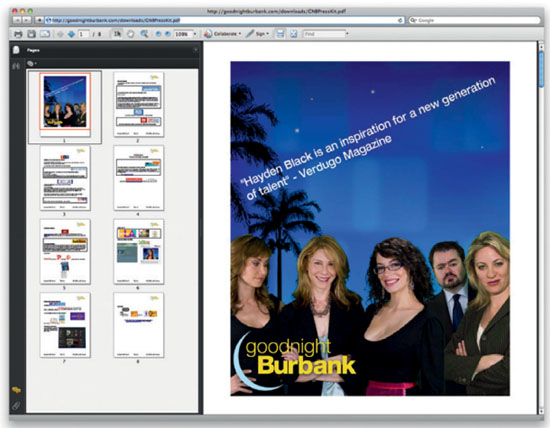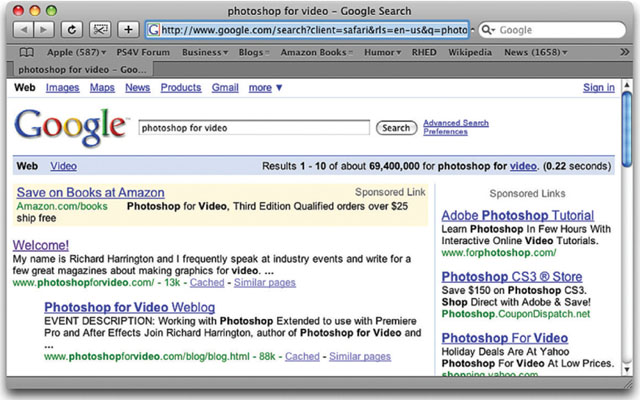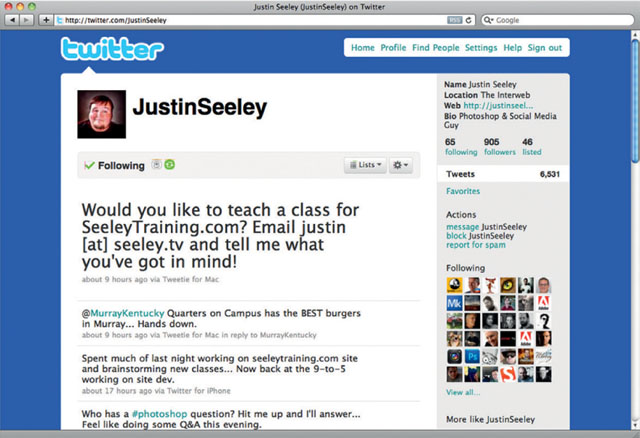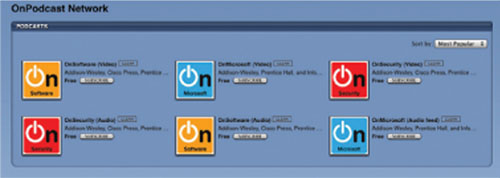PROMOTING YOUR VIDEO
As the world of web video continues to explode, getting noticed gets harder and harder. In the early days, things were much easier as the competition was poorly funded (and often produced marginal projects). These days you're likely to find yourself up against people with more money, higher production values, and perhaps the backing of major studios or media corporations.
How can you possibly compete?
It's simple (and it's how we continue to succeed). Produce good content that you are truly passionate about. Then be sure to make a lot of noise and promote that content. Don't waste your time trying to reach the masses; rather, target the groups that need you. There are many ways to raise awareness. The ideas contained in this chapter are drawn from our personal experiences as well as those of several respected experts.
Special Thanks and Good Inspiration
![]()
This chapter contains insight from four people we respect when it comes to targeting and reaching audiences. Special thanks to the following:
- Jason Van Orden, author of Promoting Your Podcast
- Paul Vogelzang, executive producer of MommyCast
- Ray Ortega, podcasting expert and community leader
- Hayden Black of Evil Global Corp., who makes some of the funniest videos on the web
Essential Groundwork
Raising a buzz might be second nature and you've got promotional headshots and biographies of all key players in your project. You've already contacted the media, been tweeting about your project, and have published your video to 30 directories.
Wait. You haven't?
It's okay. We realize that promotion is not a normal activity for most folks. Even if you live and breathe public relations and advertising, guess what? You probably have far less budget than you're used to. In this chapter we've got some practical advice to share no matter what your experience level or budget. You will frequently hear from guests in this chapter, because promotion requires many different approaches in order to succeed.
Goodnight Burbank is a highly successful web video series. it offers a complete media kit that introduces the show and features press coverage it has received. Visit www.goodnightburbank.com to learn more about the show.
A Reality Check
“The biggest challenge to promoting a show is time. It probably takes more time to promote a show than it does to write and shoot it,” said Ray Ortega. “Other challenges that go along with time are energy and drive.”
Ray Ortega (www.rayortega.com) knows from a great deal of personal experience. Producing web video is his day job as he works for a nonprofit trade association creating video content to educate members and the general public. He also produces a show about produce (“The Produce Picker Podcast”) and a podcast and Twitter feed about the art of podcasting (“The Podcasters Studio”).
“Because promotion takes so much of your time, it naturally requires that you have the energy to put in that time. Drive is as much of a factor as time and energy because if you do not have a genuine interest in your show's topic, then it will be hard for you to go out and spend time at the places where you need to be in order to get the word out about your show,” said Ortega. “Having a real interest in your topic will make it much easier for you to spend time on the web talking to others about your topic and thus creating interest in your show.”
Start with a Compelling Title
Your title is most likely the first exposure someone will have to your web video. There truly is something to the saying “You only have one chance to make a good first impression.” Your video series or episode title has only a few seconds to attract your target audience, grab their attention, and make them want to watch.
A good title instantly tells people what your show is about. Avoid “clever” puns that people have to think about. We find that being short and to the point works best. Many websites and podcast aggregators have character limits as to how many letters can be displayed.

Ray Ortega's “Producer Picker Podcast” has a clear name with nice alliteration. This improves the chance of potential users remembering the show's title.
Capture Content Early
To promote, you need something to show. But how can you promote something that doesn't exist? That's easy. Show the creation process. Get your fans onboard early though social media.
Here are a few practical ideas.
- Capture photos on set and release them through Facebook or Flickr.
- Regularly tweet about your show as it develops.
- Start a Facebook group and invite friends and colleagues. Post preview clips and photos.
- Launch a blog and post entries about your show as it unfolds.
- Cut a trailer right away and post to as many places as possible. You can even submit this trailer to places like iTunes and the Zune Marketplace to get your RSS feed validated and approved. Publish a press release and target those who are most interested in your content.
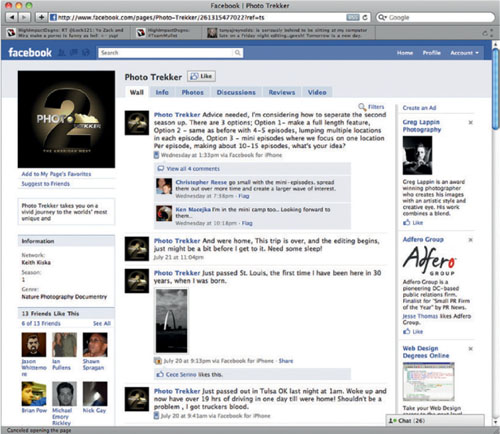
The Photo Trekker web video series (www.thephototrekker.com) uses its Facebook page to keep in touch with fans and share details about its upcoming shows:
Working with Public Relations Firms
Many web video creators with larger budgets utilize PR firms to raise awareness. With traditional media, PR firms are often a mainstay because of their extensive connections. In the world of web video though, things are so new that many PR firms aren't sure how to help.
“One of the greatest challenges in promoting a web video is cutting through the noise created by everyone else promoting a show,” said Hayden Black. “One of the solutions is hiring a professional PR firm, but then you have to find money to do that as well as making sure you've actually got a good PR firm.”
It's important when working with an outside group that you are clear about your expectations and your subject matter. No one knows your show better than you, and you probably have a pretty good idea about your target audience. Therefore, you must work as partners if you want to succeed.
“With one [web video] series we were producing, we were instructed by [the client's] PR firm not to talk to the press about the launch of the show until the day the show aired,” said Black.
The staff at the PR firm thought keeping things a secret would help build up buzz. They prevented Black and his team from releasing a promotional trailer. They also instructed the big-name stars not to talk to the press.
“I'm still not sure why [they wanted to stop] us from creating a buzz for a new show that was airing over the course of one week,” said Black. “We did what we could with the time we had and actually got a great audience, but it would have been a much bigger audience had we began promoting it even a week sooner.”
There are a few lessons learned here. First, be sure that the PR firm you work with has real experience with web video projects. Second, be sure to push for open communication with your target audience. Web video relies on transparency and “genuine” content. Third, make sure all parties involved in the project discuss their priorities and approach. Don't make assumptions that everyone shares the same approach.
Alignment with Media Partners
New media cannot ignore traditional media. Similarly, traditional media is struggling to adapt to and adopt new media techniques. How can the two help each other? The simple answer is to build a bridge. By aligning your show with traditional media outlets, you can increase your reach:
- Write a magazine column or blog post for a large website.
- Serve as a forum moderator for an online message board.
- Pitch journalists on your topic or expertise.
It's important to realize that many people still turn to traditional media. You can't ignore the reach of television, magazines, and the general web. Web video producers who partner can get a lot further than those who attempt to do everything on their own.
The proper use of tags can make your video easier to find when searching.
Keyword/Tag Development
Videos are often searched for by topic rather than name. The use of keywords and tags influences how results are generated. When you upload a video to a sharing site, you usually have a tag field. The same holds true when generating an RSS feed; you can often insert keywords into your show's description.
Typically, sites limit you to 20 tags. Just because you have this many doesn't mean you should use them all. If a video has too many tags, it can lose relevance in a search and appear lower in the results. Only tag a video with the most essential tags that accurately describe its content. Keep in mid that tags take a while to work their way through a search system. So it may take a few hours (or even days) before a search bears results.
Search Engine Optimization
There are many things you can do to make your web video more search-engine friendly. The goal is to make your video's site appear as relevant and authoritative as possible. The good news is that search engines like sites that are frequently updated (which your blog should be).
Publish a Blog

You should use a blog platform to publish a podcast and host web videos.
It provides a great home base for your video series where viewers can find archived shows and comment on each episode. Blogs are very search-engine friendly.
Unfortunately, the major search engines do not watch and index your video content. This makes the text content extremely important. Be sure to include textual show notes for each episode—detailed descriptions and content outlines that let readers and the search engines know what each episode is about. For even better ranking, consider posting transcripts of your show to provide additional text content that search engines can index.
The more other websites link to your content, the more authority you have on the Internet. More authority leads to a higher search ranking, which in turn leads to more traffic and more inbound links. The simple truth is that most people don't make it beyond the first few hits on a web search.
The best way to encourage links to your site is to regularly publish quality content. Find directories that allow you to submit your web address. Develop relationships with bloggers and podcasters who publish related content and might want to link back to you. Include links to your site when you participate in blog commenting and forum posting. You'll want to build several paths to your website (just be sure you return the favor to those who help you).
Hyper-Syndication Strategies
A guiding tenet of our publishing beliefs is that of hyper-syndication. Another way of saying this is “create once, publish many.” In this section, you'll learn practical techniques to publish your podcast or web video to as many screens as possible. This lets you take advantage of the many different viewing options on the market and grow your audience.
Hyper-Syndication Tools
Getting your content on a ton of sites takes a lot of effort. After all, imagine the time involved with uploading to 30 different websites and re-entering the same information each time. To make things easier, paid services have emerged. Let's take a look at two of the most robust, TubeMogul and blip.tv.
TubeMogul
The OneLoad service from TubeMogul (www.TubeMogul.com) offers both a robust free version (which allows for 100 videos per month) and a scaled paid service with advanced features for large publishers (priced at $50 per month and up). The principal benefit here is that it offers a single point for deploying videos to the top video and social networking sites.

You first set up accounts at any of the 30 sites supported by TubeMogul. You then upload a video to TubeMogul's site and it is sent on to the other sites. This means you need to spend a little time setting things up, but once you've published more than two videos, this method is substantially faster. The site also offers detailed analytics (for supported sites) that can show real-time viewership, geographic tracking, stream quality, and more.
blip.tv
One of our favorite services has to be blip.tv. This robust site lets you publish your video to many outlets (including nontraditional ones like TiVo and Internet-connected TVs). In fact the company claims that its network “reaches more than 80% of Americans on the Internet and a growing number of television households.”
![]()
Although we've mentioned it before, be sure to check out FeedBurner from Google (www.feedburner.com). If your video files are listed in a valid RSS file, FeedBurner makes it easy to republish that feed to many destinations.
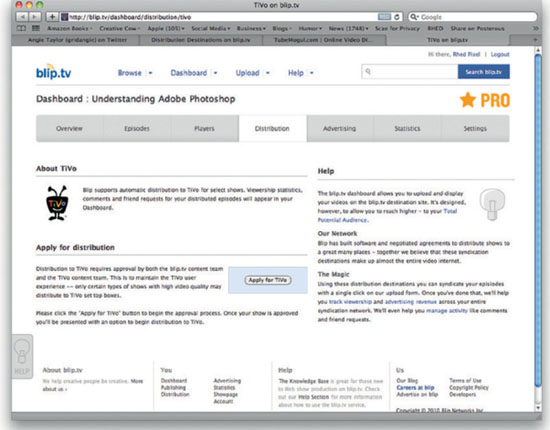
Tivo is one of the many distribution channels that blip.tv can unlock.
We really like how flexible blip.tv is, in that you can choose your distribution format. You have options to use Flash, MPEG-4, QuickTime, and more. Its player is also highly customizable and can be fully branded to your site or brand.
The service has both a free version and a paid version at $8 per month. The paid version offers priority encoding so your files are available in multiple formats. This is a great feature as it lets others resyndicate your content using a player of their choice. The control panel for the site is robust and gives you complete control over targeting specific networks and social media sites.
Video Hosting Sites
There are a myriad of websites to choose from for hosting content. Some sites are general interest and serve as large portals or search engines (think YouTube), whereas others are meant to be for specific genres or audiences (Howcast, for example, only features tutorial videos).
Here are a few sites to keep in mind for your network:
- 5min (www.5min.com)—Tutorial videos shorter than five minutes in duration.
- Bing (www.bing.com)—Microsoft's new search engine has a video directory.
- Brightcove (www.brightcove.com)—A paid service that lets you target many outlets including mobile phones.
- Cardomain (www.cardomain.com)—A site for automobile enthusiasts.
- Dailymotion (www.dailymotion.com)—A broad interest site that also has distribution to many mobile devices.
- Graspr (www.graspr.com)—A site that features educational videos only.
- GrindTV (www.grindtv.com)—A site for extreme sports videos.
- Howcast (www.howcast.com)—The site specializes in educational videos and offers applications for both the Android and Apple iOS platforms.
- iFood.TV (www.ifood.tv)—A site all about food.
- mDialog (www.mdialog.com)—A paid service that offers a flexible SDK for integrating video into iOS applications and dynamic ad insertion.
- Metacafe (www.metacafe)—Another large portal site for general interest.
- Sclipo (www.sclipo.com)—A paid site that offers e-learning systems.
- Sportpost (www.sportpost.com)—A site for sports content.
- Streetfire (www.streetfire.com)—A site for automobile enthusiasts.
- StupidVideos (www.stupidvideos.com)—A site for humorous videos.
- Viddler (www.Viddler.com)—A free service for video distribution.
- videojug (www.videojug.com)—The site only offers “factual” content rather than entertainment.
- Yahoo! Video (video.yahoo.com)—A general interest search directory by the search engine company.
- Zoopy (www.zoopy.com)—A site that offers video, audio, and photo sharing on one site.
iTunes Searching: How Will You Be Discovered?
There are three ways a potential subscriber can find you in the iTunes Store. Understanding the three methods is important if you want to improve your chances of being found.

1. Search. The iTunes Store contains a search field. Results are returned based on popularity and relevance. Popularity relates to the number of new subscribers you've had in a given period (which is an uncontrollable factor). Relevance is due largely to your show's description and keywords (which you have complete control over). Be sure to write an accurate description that addresses your show's topic. You can also use keywords to address misspellings or additional search criteria.
2. Featured content. The iTunes Store routinely features content. There are several factors that contribute to a show being featured. First and foremost, the quality of content is considered. Second, your show must have attractive artwork (which does not include Apple items like logos or iPods). The staff at the iTunes Store also favor shows with consistent content that is released regularly (e.g., weekly or daily). It should also go without saying that your feed needs to be valid, so periodically check it at www.feedvalidator.org.
3. Top lists. On each page of the iTunes Store there is a “Top List.” These lists showcase the top shows in each category. These lists are based on new subscriptions. We often recommend launching a show with four episodes (simply predate the first three to offset their “release”). This way a new show offers visitors multiple options. This initial surge can help you make a splash. Once you are on a Top List, it is essential you maintain your release schedule and quality. Staying on a Top List is very helpful, as it makes it much easier for visitors to discover your show.
Ping-0-Matic can automate the process of notifying websites about your new podcast.
Notifying Directories Automatically for RSS Feeds
Each time you post a new episode of your show to an RSS feed, you want several directories to immediately crawl, index, and list the new content. The easiest way to make sure this happens is to send an instant notification, called a “ping.” If you use a blog to publish your show, the blog software can be configured to do this for you automatically, each time you post a new episode.
Another option is to visit www.pingomatic.com each time you post new content. Submit your feed, and Pingomatic will automatically notify the most important directories. If you don't manually ping the directories, it can take a few days for new content to appear.
Social Media Tools
These days you'll hear a lot of the miracles of social media. Our take is that this is simply a new name for a practice that's existed since the start of the Internet. We remember being in college and belonging to online bulletin boards and groups about some of our favorite hobbies and interests. We shared photos and video; we interacted with others (and this was the early 1990s).
Of course, social media is now all the rage. Multiple generations from grandkids to grandparents share videos, pictures, and text updates regularly. If you make a concentrated effort to engage folks this way, you can see real results.
“We reach out to our fans and speak to them so they can feel more connected. That's something that you simply can't do with TV. TV has more of an ‘us versus them’ vibe, with ‘them’ being the audience. There's an aloofness there,” said Black. “But with the Net you can Twitter or email the casts and crew so there's more of a duty to connect with people who are reaching out to you to tell you they're a fan. Once you do that, fans are far more willing to help out because they feel engaged and part of the process.”

Hayden Black uses his Facebook page to stay in touch with fans. Witty updates keep his audience engaged and often generate comments.
But be careful of social media overload. Although repetition is okay, it needs to be done creatively. Don't just blast the same message to Twitter, Facebook, your email list, and press releases. You'll need to get creative and stagger your messages.
“When you're on a grassroots budget [social media] is about 100% of the way you can promote. But you have to tread a fine line and not piss people off by targeting them over and over on different platforms,” said Black. “Nothing turns me off of wanting to watch something when the producer has contacted me five different ways.”
Enabling Share Technologies

The viral nature of social networks has created a marketing nirvana. People can instantly share content with their entire social circle. By making it easy for your audience to share your content on popular social networks, you will increase the reach of your show. Popular social networks include Digg.com, Del.icio.us, Facebook.com, and StumbleUpon.com. These sites provide bookmark widgets that you can include on your site so visitors can share your content with one click. It is a good idea to add these to your show's blog.
Metadata Is Essential

Your show needs good metadata so people can find your podcast. This includes all of the information that describes your podcast to the potential subscriber, as well as to podcast directories.
Besides your show's title, author, and description, you can use up to 12 keywords to determine relevance. A high percentage of potential subscribers look for podcasts using searchable directories. If you don't have useful, robust metadata, your podcast will not turn up.
Twitter Essentials
Twitter is a short messaging service that lets interested people follow the activities of others—no, not in a stalking sort of way; only the information that one group decides to share with others. What makes this so effective is that you can post quick updates about your web video.
Many mobile phone applications support Twitter. This means you can quickly post photos, video, or text updates right from the set or location shoot. As comments come in, you can interact with others in a meaningful (albeit short) exchange. Twitter takes a little getting used to (we recommend lurking for a few weeks to get the hang of it). Watch how others you admire or respect use the tool to get ideas.
Justin Seeley is an active web video producer who keeps his audience up to date through twitter (http://twitter.com/JustinSeeley).
What we've found is that it's the best way to connect with our most interested fans. These fans are also the most likely to post or share information about our videos and products.
Ray Ortega also uses Twitter as an inspirational tool to discover topics for new shows he produces. He also builds a loyal following of viewers.
Schedule Tweets
![]()
One service we use is SocialOomph.com. This lets you schedule tweets to come out over time. It lets you set up a message and have it trickle out or even repeat. The site offers both free and paid services.
“Twitter allows me to monitor search terms related to my show, such as ‘fruit,’ ‘vegetable,’ ‘ripe,’ et cetera,” said Ortega. “When I notice people talking about or asking questions, I can respond quickly and with very little effort I have gained a potential new viewer and almost certainly made a connection with someone who shares my passion.”
“Conversations in Public relations” is a web video series focusing on luminaries in Pr. the show uses its Facebook page to publish its video.
Facebook Essentials
Facebook has grown incredibly since its launch (with many calling it Internet crack). With currently more than 500 million active users, Facebook truly is the Internet's gathering place, with more than 30 billion content posts per month. Plus, other websites tie into Facebook to allow for sharing of content back and forth (more than 1 million current connections).
What does this mean to you? Well, you better set up a Facebook page for your web video series, production company, or host. This page should ideally be a Facebook page (and not a personal profile). You can set up a page by visiting www.facebook.com/pages/create.php. These pages are much more flexible and allow you to share and interact more easily with fans of your show.
While you are on Facebook, be sure to look for groups that match your show's topic. Becoming an active member of several groups lets you gain exposure to potential viewers and will serve as a source of inspiration for new content. For more on creating and joining groups, see Facebook's online help (www.facebook.com/help).
Make a Widget
![]()
Want to make a Facebook application or easy widget to share your content? Widgetbox.com lets you create easy-to-share widgets for distributing videos on websites with easy sharing technology.
Live Engagement
Some video creators stream their shows’ creation live. This works particularly well for shows that do not rely on much editing (such as talk shows). This method lets the most interested fans tune in from the start and even shape the content of the video.
“Sometimes when the show is recorded, I also live stream the process so that others can join in and get a behind-the-scenes view of what it takes to produce an episode,” said Ortega. “This also allows me to gain feedback instantly. I can ask the audience their opinion on what I'm about to film and make changes to the production in real time. Including your audience in the process of production gives them a feeling of ownership, and they are certain to become the core group of people who will rally others around your content.”
UStream
![]()
If you'd like to stream your video program live for free, check out www.ustream.tv. This site is easy to use and offers easy tools for creating a stream on a laptop or desktop computer.
Additional Promotional Strategies
While we're talking about promotion, there are several other methods that bear mention. The techniques covered in this chapter won't work in every case. Be sure to explore and experiment to determine the best “media mix.” Here are a few other techniques that have worked for us and our colleagues.
A Great Book on Podcast Promotion
![]()
Promoting your podcast is essential to its long-term success. Although we've explored several ideas in this chapter, we highly recommend Promoting Your Podcast by Jason Van Orden. You can find out more on the book at www.promotingyourpodcast.com.
Cross-Promote with Other Internet Shows
An effective way to find potential listeners is to target the audiences of shows that are similar to your own. Most podcasters and video creators don't believe in the “pie theory,” which says there's an infinite number of listeners that can only be divided so many ways.
“I often tell people not to reinvent the wheel when it comes to promotion. Go to where your audience already is. You don't have to spend all of your time searching the web and forums to reach one person at a time. Find out where people are gathering around content in your niche,” said Ortega.
We have found that many are willing to share their audiences through cross-promotion strategies. We regularly interact with other video producers and even contribute to their shows.
“In the beginning most people will view this as competition. You should view this as opportunity, an opportunity to instantly expose hundreds or thousands of people to your show,” said Ortega. “In most cases you have an individual take on the same topic and there is certainly room for people with like content to share an audience.”
Podcasters enjoy using content from outside sources to make their shows more interesting. Find shows that relate to your topic, then contribute content that adds value to those shows and that promotes your show at the same time. Here are some suggestions from Jason Van Orden:
- Offer to be a guest on other podcaster's shows, and then return the favor by inviting them on your show.
- Produce guest segments or serve as a field producer for another podcast.
- Add questions or comment to other show's blogs. Be sure your show is mentioned in your signature line.
- Consider exchanging show promotional announcements with other podcasters.
Advertise and Promote
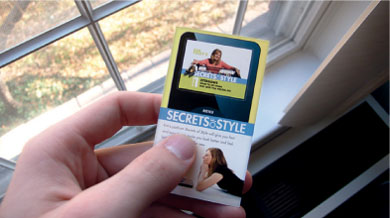
This may sound obvious, but you need to promote your show. This includes running ads in traditional venues like magazines or websites. One technique we employ is creating a business card for each of our podcast series. In this way, when we talk up the show with people we meet, they can easily remember the show name and blog when they get to their computer. You don't need to spend a fortune on advertising—many podcasters trade ads with one another, placing ads in their shows for certain products or events, then asking for links or ads in exchange.
Aggregate Your Content
If you produce multiple podcasts that could appeal to the same audience, then be sure you aggregate and cross-promote. For example, you can list other shows on your blog page. We often add blog posts about other shows to promote crossover content that should appeal to the audience.
You can also create an artist page on iTunes. This is a single page that lists all your shows in one place. Simply click on the Report a Concern button, and select Remove a Podcast. In the dialog box, explain that you would like an artist page, give the exact name of the artist (don't include “Inc.,” “LLC,” etc.), and list the exact feed URLs or links to your podcasts. Note that a podcast can only appear on one artist page.
Pulling multiple series together on iTunes is a good way to expose fans to other shows you produce.
When using services like YouTube, you can keep videos grouped together under one account. Since accounts are free, we recommend that you set up a page for your production company or even just your show. This will put all of the videos onto a single page and make it much easier for people to discover your content.
Word-of-Mouth Marketing
The use of word-of-mouth marketing relies on communication between two people. The term has grown to include social media but still refers to an influencer talking (or posting) about a product or service to the person's peers. This type of communication is often seen as being credible, because the recommendation comes from a known source and not a commercial source.
Feedback from viewers is very important. encourage fans and colleagues to post reviews as they often influence potential viewers and drive up a video's ranking.

“Word of mouth is probably your best marketing strategy. Getting the viewers you already have involved in the process of promoting your show is an easy way to grow your audience,” said Ortega. “I ask people to become a friend of the show on Facebook, Twitter, or any number of social networking sites. This allows me to know who is watching and to connect with them beyond the simple act of them watching my content.”
Once fans connect, it's much easier to build a web of influence. As you release news or content, they will be automatically notified. They can also talk about you to others in their network and easily share content. The key, though, is to not just “talk at” your audience but rather to “talk with.”
“When you listen to your audience and have real interactions with them, you build a relationship with your content and brand that is oftentimes much stronger than their experience with traditional media,” said Ortega. “These people in turn write about you on their blogs, send out tweets about each episode you produce, or pass the word through their own social network, exposing many others with like interests to your content.”
Word of Mouth Marketing
![]()
Word-of-mouth marketing is so popular that there's an actual professional group, Word of Mouth Marketing Association (www.womma.org/main).
Its website offers several free resources worth exploring.
Getting Press Coverage
Getting traditional media coverage is not as hard as you think. We've found a few practical approaches that increase the likelihood of good press. Here are three of our favorite techniques:
- Be sure to have photos easily accessible. The press loves pictures, so not having photos is often a deal-breaker. Post stills to your website that show both the finished product and behind the scenes.
- don't be shy, but at the same time don't annoy. Journalists often are spread thin these days with budget cuts. By following up and being responsive, you'll be seen as a good source.
- Lastly, be sure to pitch your content in relationship to a bigger angle. For example, perhaps your show is about saving energy and a better environment. Pitch journalists on Earth Day or when green energy initiatives are up for a vote. Tie yourself to your content and pitch when relevant.
Once you've built a relationship with a member of the press, be sure to maintain it. Remember that most journalists have a job to do, and that is to find and report on stories that are of interest to their readers. If you are easy to access and genuinely open, they'll likely revisit you.
Hayden Black has firsthand experience in keeping a healthy relationship with press.
“I have been very lucky in that 99.9% of the press I've gotten has been generated by the press itself,” said Black. “I've built on the relationships I've made with journalists after articles have been written.”
Many journalists (as well as fans) follow Black on Twitter or Facebook. Because comedy is his business, his feeds don't disappoint.
“I use Twitter too [@HaydenBlack and @GoodniteBurbank], but as an outlet primarily for jokes. Every so often I throw in a bit of marketing so people don't get burned out with it.”
Build a Relationship with Your Audience
Although attracting new subscribers is important, long-term success comes from maintaining the subscribers you already have. To do this, you must build a meaningful relationship with your audience. Here are a few ways to connect and build on that connection.

© iStockphoto.
Stay Focused
What is your show all about? Perhaps you should write it down “for the record.” Many web video creators struggle to come up with new show topics. As such, their shows drift away from the intended topic (and subsequently lose both their focus and their viewers). One recommended technique is mind-mapping, which involves visually organizing information. You can essentially start with a few core topics and keep breaking them down into related ideas to come up with new show topics. You can find out more on mind-mapping at www.en.wikipedia.org/wiki/Mind_map.
Remember Who Watches
Do you know who watches your videos? Be sure you have a target audience in mind when you develop show ideas. One thing we find useful is to look at our podcast page in iTunes. Here we can see a section called “Listeners Also Subscribed To.” You can follow the links listed there and discover what other shows your listeners are consuming. You'll also see similar features on most video-sharing sites when other recommended content is presented. This can help you develop an overview of what your audience is interested in.
Interact with Your Audience
You want to provide your audience a way to speak back to you. This can mean an email address or voicemail line. Another way is to allow commenting on your blog or allow forums. When your audience members speak up, answer them. Include their comments in the show. Thank them for participating. Respond to what they say.
You should also include surveys on your website or blog. We frequently use the survey tools from MajikWidget (www.majikwidget.com). Others employ the more detailed Survey Monkey (www.surveymonkey.com). Whatever technology you use, people like having a chance to voice their opinion.
Another option is to be sure to visit places where people visit who'd be interested in your content. This means hanging out in forums or social networking groups. Remember though, it's not enough to just find the people who would be most interested in your content and posting a link. Ray Ortega insists that you need to actually engage with people in a genuine fashion such as answering their questions or commenting on their content.
“It's important to be cautious about simply going to another site and posting a link to your show. This is quickly written off as spam and rightly so. If you are there for the purpose of only promoting your show, you are going to lose. You are more likely to do more damage to your show's name/brand than you are to promote it,” said Ortega. “If you get pegged as a spammer, then your brand is tainted. If on the other hand you enjoy the conversations with people who share your own (and your show's) interest, then you are likely to do yourself a huge favor by reaching the people you are shooting your show for in the first place.”
At Evil Global Corp., Hayden Black has gone as far as actually integrating fans into the show. He knows that people who like his style of comedy should like his new video series as well. He goes out of his way to interact with fans through social media.
The use of surveys on a blog or website is a great way to involve your audience.

“We were one of the first web shows to use Twitter within a scripted show. In The Occulterers, we created a mock ‘live feed’ from the castle that the bungling ghost hunters were spending each night in and then invited fans to tweet what they saw to the ghost hunters,” said Black. “We got inundated with people telling us what they saw or what they heard, and we used their Twitter names in the show to report what was being seen.”
Watch Other Shows in Your Space
Do you know what your video's competition is? It's important to periodically check out what other shows are doing. You can learn a lot by analyzing shows and videos that are ranked both above and below yours. You'll want to look at them for ideas on content and approach.
In some ways you can counter-program. For example, if your competition is fairly dry, you can integrate light humor. If other shows are very long, try taking the abbreviated approach. What you should do is analyze the market, looking for both ways to make your show stand out and best practices.

Build Your Brand and Host Recognition
We have found that establishing credibility and building a brand have been helpful in the long run. Podcast hosts should look to improve their “terrestrial” credibility by speaking at conferences as well as offering interviews to traditional media.
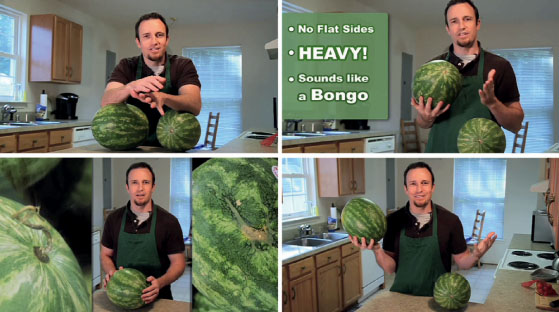
The “Produce Picker Podcast” saw significant growth once it loosened up its format and let humor into the show.
We also find that showing the host on camera works well. Be sure to give some face time to your host, rather than just focusing on the subject of an interview or source of a technical demonstration.
“In the beginning the show was pretty raw, just a video of my hands showing people how to select and prepare fresh fruits and vegetables. The next step was getting myself in front of the camera, and once I did that I realized the show could use a touch of humor,” said Ortega.
Ortega pointed out that many web video producers feel trapped by “traditions” or “rules” of broadcast television. Web video is a much more open medium, however.
“[Originally] the show was basically a green grocer format, something you'd see on any local newscast or public access channel. But I quickly realized that this was not traditional TV and in fact it was the web, where you can do virtually anything you want,” said Ortega. “I decided it was time to add some fun into the show. Thus began a tradition that usually involves me getting pelted with whatever fruit or vegetable happens to be featured on a given episode. So in that way, having food thrown, dropped, or just generally making a mess was an unusual approach to the kind of content I'm producing. People have definitely commented on the humor element to the show, and it sticks out as something they like seeing.”

Make It Easy to Subscribe
It is important that you make subscriptions easy. This means you need to recognize that your audience may have different desires regarding technology than you. Make sure that you offer both RSS subscriptions and one-click subscribe buttons for several popular formats. Usually your host company can help with this; if not, you should harness the power of FeedBurner (www.feedburner.com).
You'll also want to take advantage of any tools offered by video-sharing sites. These include share buttons to popular social media sites and channel subscriptions.
One overlooked technology is email. A surprising number of folks still want to be emailed when new episodes come out. We usually turn to FeedBurner for this, but other sites also offer the option for users to be emailed.


